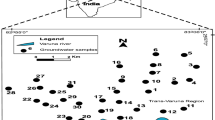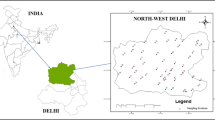Abstract
The study aims to discuss elaborately about the origin of physical disabilities amongst the locals of Pure village in Varanasi district, India through proper hydrogeochemical facies, multivariate statistics and correlations, saturation indices of mineral phases, speciation of heavy metals, radiation surveys, and comparing the values of major ions and heavy metals with respect to the permissible limits of USEPA, WHO, ICRP, and BIS standards. The evolution of water is Ca-Mg-HCO3 type, as evident from Piper trilinear plot, with neutral to feeble alkalinity. From Gibbs’s diagram, origin of major ions in groundwater is found primarily to be chemical weathering of the rock forming minerals as all the samples fall in rock dominance zone. Mineral saturation indices modelling by PHREEQC suggest supersaturation of water with goethite, hematite, Fe(OH)3(a), and dolomite. Speciation studies of PG-4 having high U concentration (13 µg/l) reveal dominance of U4+ and Fe2+ species, thus confirming reducing environment in aquifer. The high concentration of iron minerals in water promotes adsorption of U4+ on their matrices thus reducing effective U concentration in water. The U values are higher in most of the drinking water samples as per safe limits indicated by ICRP and WHO suggesting that long-term use for drinking purpose may cause serious health crisis. Higher Sr values (119 ± 39 µg/l) in groundwaters, greater than minimum reporting level, as per USEPA, may be one of the contributing factors for physical disabilities of inhabitants.
Similar content being viewed by others
References
APHA (2006) Standard methods for the examination of water and waste. American Public Health Association, Washington DC.
Ariunbileg, S., Gaskova, O., Vladimirov, A., Battushig, A., Moroz, E. (2016) Spatial distribution of uranium and metalloids in groundwater near sandstone-type uranium deposits, Southern Mongolia. Geochem. Jour., v.50(5), pp.393–401.
Bureau of Indian Standards (2012) Indian standard specifications for drinking water. 10500: BIS: New Delhi, India.
Chatterjee, S., Dutta, A., Gupta, R. K., Sinha, U. K. (2022) Genesis, evolution, speciation and fluid-mineral equilibrium study of an unexplored geothermal area in Northeast Himalaya, India. Geothermics, v.105, pp.102483.
Cheng, T., Barnett, M.O., Roden, E.E., Zhuang, J. (2007) Reactive transport of uranium (VI) and phosphate in a goethite-coated sand column: an experimental study. Chemosphere, v.68(7), pp.1218–1223.
Cordeiro, J.M., Gonçalves, P.P., Dunant, Y. (2011) Synaptic vesicles control the time course of neurotransmitter secretion via a Ca2+/H+ antiport. Jour. Physiol., v.589(1), pp.149–167.
Dutta, A., Gupta, R.K. (2022) Geochemistry and Utilization of Water from Thermal Springs of Tawang and West Kameng Districts, Arunachal Pradesh. Jour. Geol. Soc. India, v.98, pp.237–244.
Dorsey, A.F., Fransen, M.E., Diamond, G.L., Amata, R.J. (2004) Toxicological profile for strontium. Agency for Toxic and Substances and Disease Registry (ATSDR): Atlanta, GA, USA, pp.445.
Gibbs, R.J. (1970) Mechanism controlling world water chemistry. Science, v.170, pp.795–840.
Guggenbuhl, P., Fergelot, P., Doyard, M. et al. (2011) Bone status in a mouse model of genetic hemochromatosis. Osteoporos. Int. v.22, pp.2313–2319.
Guo, Z., Li, Y., Wu, W. (2009) Sorption of U (VI) on goethite: effects of pH, ionic strength, phosphate, carbonate and fulvic acid. Appl. Radiat. Isot., v.67(6), pp.996–1000.
Grundl, T., Delwiche, J. (1993) Kinetics of ferric oxyhydroxide precipitation. Jour. Contam. Hydrol., v.14(1), pp.71–87.
Hossain, M., Patra, P. K. (2020). Water pollution index-A new integrated approach to rank water quality. Ecol. Indic., v.117, pp.106668.
ICRP-30 (1979) Limits for intake of radionuclides by workers, International Commission on Radiological Protection, Pergamon Press, Oxford, UK.
Katsoyiannis, I.A., Althoff, H.W., Bartel, H., Jekel, M. (2006) The effect of groundwater composition on the sorption of uranium (VI) onto bacteriogenic iron oxides. Water Res. v.40, pp.3646–3652.
Machiwal, D., Jha, M.K. (2015) Identifying sources of groundwater contamination in a hard-rock aquifer system using multivariate statistical analyses and GIS-based geostatistical modeling techniques. Jour. Hydrol.: Reg. Stud., v.4, pp.80–110.
Nair, S., Merkel, B.J. (2011) Impact of alkaline earth metals on aqueous speciation of uranium (VI) and sorption on quartz. Aquat. Geochem., v.17, pp.209–219.
Parkhurst, D., Appelo, C.A.J. (2013) Description of input and examples for PHREEQC version 3-a computer program for speciation, batch-reaction, one-dimensional transport, and inverse geochemical calculations: U.S. Geological Survey Techniques and Methods. Book 6, c-A43.
Rao, N.S., Chaudhary, M. (2019) Hydrogeochemical processes regulating the spatial distribution of groundwater contamination, using pollution index of groundwater (PIG) and hierarchical cluster analysis (HCA): A case study. Groundw. Sustain. Dev., v.9, pp.100238.
Schoeller, H. (1977) Geochemistry of Groundwater. In: Groundwater Studies—An International Guide for Research and Practice. UNESCO, Paris.
USEPA (2014) Announcement of preliminary regulatory determinations for contaminants on the third drinking water contaminant candidate list; proposed Rule. Fed. Regist., v.79(202), pp.62715–62750.
USEPA (2015) The Third Unregulated Contaminant Monitoring Rule (UCMR 3): Data Summary. EPA 815-S-15–002. U.S. Environmental Protection Agency, Washington, D.C.
Wang, Y., Wang, J., Li, P., Qin, H., Liang, J., Fan, Q. (2021) The adsorption of U(VI) on magnetite, ferrihydrite and goethite. Environ. Technol. Innov., v.23, pp.101615.
WHO, World Health Organisation (2003) Background document for the development of WHO guidelines from drinking water quality. WHO/SPE/WSH/03.08/118.
Yadav, S.K., Ramanathan, A.L., Kumar, M., Chidambaram, S., Gautam, Y.P., Tiwari, C. (2020) Assessment of arsenic and uranium co-occurrences in groundwater of central Gangetic Plain, Uttar Pradesh, India. Environ. Earth Sci., v.79(6), pp.1–14.
Acknowledgement
The authors acknowledge ADG and HOD (NR) and all colleagues of Geological Survey of India, Lucknow for constant support. The authors would like to acknowledge the associate editor and the anonymous reviewer for their enormous meticulous efforts in greatly improving the quality of manuscript.
Author information
Authors and Affiliations
Corresponding author
Electronic Supplementary Material
Rights and permissions
About this article
Cite this article
Singh, P.K., Singh, S.K., Debnath, S. et al. Integrated Multivariate Analysis, Hydrogeochemical Modelling and Speciation Studies to Reveal Geogenic Origins behind Physical Disabilities: A Case Study in Pure Village, Varanasi, India. J Geol Soc India 98, 1731–1736 (2022). https://doi.org/10.1007/s12594-022-2244-2
Received:
Accepted:
Published:
Issue Date:
DOI: https://doi.org/10.1007/s12594-022-2244-2




